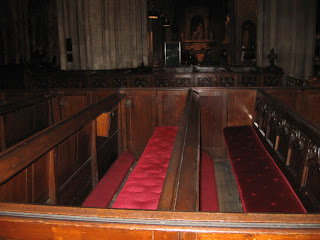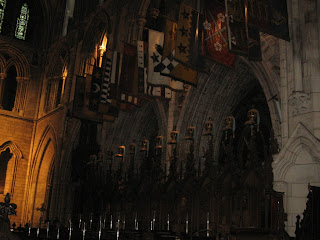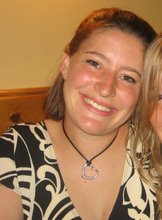.jpg) Up until three years ago, only Gaelic games were permitted to be played on these grounds. Those damn Brits had to take their evil rugby and soccer to another venu.
Up until three years ago, only Gaelic games were permitted to be played on these grounds. Those damn Brits had to take their evil rugby and soccer to another venu. .jpg) The floodlights have to be something around a 100x brighter than those in soccer and rugby stadiums because in order to be able to see a hurling ball moving 80 miles per hour you need daylight, more or less.
The floodlights have to be something around a 100x brighter than those in soccer and rugby stadiums because in order to be able to see a hurling ball moving 80 miles per hour you need daylight, more or less..jpg) This section of the stadium is usually standing room only; but to accomodate FIFA regulations they installed removable seats. The stadium houses 200 more people without the seats.
This section of the stadium is usually standing room only; but to accomodate FIFA regulations they installed removable seats. The stadium houses 200 more people without the seats.
.jpg) The creation of the GAA (Gaelic Athletic Association) and the subsequent institutionalization of Gaelic sport went hand in had with the Irish nationalist movement. Many of the head board figures were also key players in the movement. The English banded all Gaelic games in Ireland for a period. They also bombed a section of the stadium during a football championship match killing spectators and I one player. There is a section of the stadium named after him.
The creation of the GAA (Gaelic Athletic Association) and the subsequent institutionalization of Gaelic sport went hand in had with the Irish nationalist movement. Many of the head board figures were also key players in the movement. The English banded all Gaelic games in Ireland for a period. They also bombed a section of the stadium during a football championship match killing spectators and I one player. There is a section of the stadium named after him..jpg) A section of the stadium was built extending over train tracks. The railway owns the air 100 meters above the track. The GAA has leased this air for the next 50 years. Or something like that.
A section of the stadium was built extending over train tracks. The railway owns the air 100 meters above the track. The GAA has leased this air for the next 50 years. Or something like that.
.jpg)
.jpg)
.jpg)

.jpg) I think this is the National Library...or maybe it was the National Museum. I forget, I went to both of them.
I think this is the National Library...or maybe it was the National Museum. I forget, I went to both of them..jpg) Christ Church Cathedral.
Christ Church Cathedral..jpg) The lady justice at Dublin Castel is facing inward with her back to the public. Ironic when you think that this was the seat of the English government in Ireland for so many years. When it rained the scales would noticably tip to one side. Also ironic. They ended up drilling wholes in the bottom so this wouldn't happen anymore.
The lady justice at Dublin Castel is facing inward with her back to the public. Ironic when you think that this was the seat of the English government in Ireland for so many years. When it rained the scales would noticably tip to one side. Also ironic. They ended up drilling wholes in the bottom so this wouldn't happen anymore..jpg)
.jpg) The garden next two St. Patrick's recognized many famous Irish writers. I think this one is George Bernard Shaw.
The garden next two St. Patrick's recognized many famous Irish writers. I think this one is George Bernard Shaw..jpg)
.jpg) Does anyone besides me think that it is interesting that the two most famous churches in Dublin are Church or Ireland churches? And there are English flags flying inside (although, not in this picture).
Does anyone besides me think that it is interesting that the two most famous churches in Dublin are Church or Ireland churches? And there are English flags flying inside (although, not in this picture)..jpg) One of my favorite things in Dublin was the shamrock design on the street lamps!
One of my favorite things in Dublin was the shamrock design on the street lamps!.jpg)






.jpg) Grafton Street
Grafton Street
.jpg) St. Stephen's Shopping Center
St. Stephen's Shopping Center.jpg)
.jpg) The Dublin Spear. It's really tall. And blows a lot in the wind. That is all.
The Dublin Spear. It's really tall. And blows a lot in the wind. That is all..jpg) St. Stephen's Green, take 1
St. Stephen's Green, take 1.jpg) take 2
take 2.jpg) take 3
take 3.jpg) take 4
take 4
.jpg)
.jpg)
.jpg)
.jpg)
.jpg)
.jpg)
.jpg)

.jpg)
.jpg)
.jpg)
.jpg)

No comments:
Post a Comment